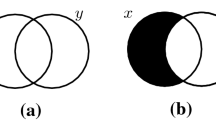Abstract
Resolution proofs are unstructured by their very nature, since theycannot use substantial lemmata. To impose structure on given resolutionproofs and thereby improve their readability we will introduce new lemmatain a postprocessing step. As these lemmata cannot be generated byresolution, we will employ function introduction rules as presented by Baazand Leitsch and give a correct and complete criterion for theirapplicability to the proofs. Applying function introduction rules toresolution proofs enables us to detect and eliminate certain homomorphicsubproofs immune to the known redundancy elimination rules. For the caseswhen the criterion is satisfied we will characterize the transformation oftree resolution proofs to their condensation-reduced functional extensions,which may result in a double exponential reduction of proof height.Moreover, the proofs obtained by this transformation are more structured andhence more intelligible.
Similar content being viewed by others
References
Andrews, P. B.: Theorem proving via general matings, J. ACM 28(1981), 193–214.
Baaz, M. and Leitsch, A.: Die Anwendung starker Reduktionsregeln in automatischen Beweisen, Proc. Austrian Acad. Sci. II 194(1985), 287–307.
Baaz, M. and Leitsch, A.: A strong problem reduction method based on function introduction, in Proc. ISSAC’90, ACM Press, New York, Addison-Wesley, Reading, MA, 1991, pp. 30–37.
Baaz, M. and Leitsch, A.: Complexity of Resolution Proofs and Function Introduction, Ann. Pure Appl. Logic 57, North-Holland, Amsterdam, 1992, pp. 181–215.
Baaz, M. and Leitsch, A.: On Skolemization and proof complexity, Fundamenta Informaticae 20(1992), 353–379.
Bibel, W.: Matings in matrices, Comm. ACM 26(1983), 844–852.
Bibel, W.: Automated Theorem Proving, Vieweg, Braunschweig, 2nd edition, 1987.
Bibel, W.: Deduction: Automated Logic, Academic Press, London, 1993.
Eder, E.: An implementation of a theorem prover based on the connection method, in AIMSA 84, North-Holland, Amsterdam, 1984.
Eder, E.: Relative Complexities of First Order Calculi, Vieweg, Wiesbaden, Germany, 1992.
Egly, U.: Shortening proofs by quantifier introduction, in LPAR’92, LNAI 624, Springer, Berlin, 1992, pp. 148–159.
Egly, U.: On different concepts of function introduction, in KGC’93, LNCS 713, Springer, Berlin, 1993, pp. 172–183.
Egly, U.: On Methods of Function Introduction and Related Concepts, Dissertation, Technische Hochschule Darmstadt, 1994.
Eisinger, N., Ohlbach, H. J. and Präcklein, A.: Reduction rules for resolution-based systems, Artificial Intelligence 50(1991).
Gentzen, G.: Untersuchungen über das logische Schließen I–II, Math. Z. 39(1934), 176–210, 405–431, reprinted in Gerhard Gentzen, The Collected Papers of Gerhard GentzenM. E. Szabo (ed.), North-Holland, Amsterdam, 1969.
Gottlob, G. and Fermüller, Ch.: Removing redundancy from a clause, Artificial Intelligence 61(1993), 263–289.
Gottlob, G. and Leitsch, A.: On the efficiency of subsumption algorithms, J. ACM 32(2)(1985).
Joyner, W. H.: Resolution strategies as decision procedures, J. ACM 23(1978), 398–417.
Lee, S.-J. and Plaisted, D. A.: Eliminating duplication with the hyper-linking strategy, J. Automated Reasoning 9(1992), 25–42.
McCune, W. W.: OTTER, 2.0 Users Guide, Technical report ANL-90/9, Argonne National Laboratory, Argonne, IL, 1990.
Plaisted, D. A.: Abstraction using generalization functions, in CADE-8, LNCS 230, Springer, Berlin, 1986, pp. 365–376.
Plaisted, D. A. and Greenbaum, S.: A structure preserving clause form translation, J. Symbolic Computation 2(1986), 293–304.
Prawitz, D., Prawitz, H. and Voghera, N.: A mechanical proof procedure and its realization in an electronic computer, J. ACM 7(1960), 102–128.
Prawitz, D.: Advances and problems in mechanical proof procedures, Mach. Intell. 4(1969), 59–71.
Robinson, J. A.: A machine-oriented logic based on the resolution principle, J. ACM 12(1) (1965), 23–41.
Slaney, J.: The crisis in finite mathematics: automated reasoning as cause and cure, in CADE-12, LNAI 814, Springer, Berlin, 1994, pp. 1–13.
Tseitin, G. S.: On the complexity of derivation in propositional calculus, Automation of Reasoning, J. Siekmann and G. Wrightson (eds), Springer, Berlin, 1983, pp. 466–483.
Author information
Authors and Affiliations
Rights and permissions
About this article
Cite this article
Hörwein, K. Structuring Resolution Proofs by Introducing New Lemmata. Journal of Automated Reasoning 19, 173–203 (1997). https://doi.org/10.1023/A:1005890730317
Issue Date:
DOI: https://doi.org/10.1023/A:1005890730317




